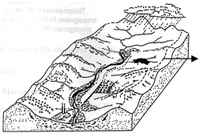|
Watershed Management Anand Kumar anand@sdalt.ernet.in L and and water are the basic natural resources for biomass production and constitute the core of ecological systems. Our natural resource base is under great stress in many parts of the country due to severe biotic pressure and ever intensifying development, as is evident from the current scenario and projected demands. The current scenario and future projections will amply demonstrate that scientific planning and management of the natural resources has now become an imperative rather than an option for sustainable development of India.In recent times, development of land and water resources is being planned on the basis of natural hydrological entities (like watersheds), rather than the administrative boundaries. Such development plans are sustainable in nature. In fact, they facilitate the conservation of ecology and enhancement of the productivity of mankind. The watershed approach is more rational because the resources of land and water have optimum interaction and synergistic effect when developed on a watershed basis. What is a Watershed?
A watershed is a defined area that has an undulating terrain from which the entire rain water drains through a single outlet. This outlet may be a nallah, stream, tributary or a large river. A watershed can cover a large multi-state area or a relatively small area, like the watershed of a small stream, pond or wetland. Larger watersheds are made up of numerous smaller watersheds, often called sub-watersheds or sub-basins. Of all the units possible for containing a conservation project - villages, states, provinces, and countries - the only "natural" project area is that of a watershed. It is natural because it allows planners to focus on all the effects of downhill run-off in a given area and to plan accordingly to control or contain it. Why Watershed?
What is Watershed Management? Watershed management is the rational utlilization of land and water resources for optimum production with minimum hazard to natural resources. It essentially relates to soil and water conservation in the watershed which means proper land use; protecting land against all forms of deterioration; building and maintaining soil fertility; conserving water for farm use, proper management of local water for drainage; flood protection and sediment reduction; and increasing productivity from all land uses. It is a plan of activity geared towards attaining specific goals. The overall objectives of all watershed management programmes are:
|
||||||||||||||||||||||||||||||||||||||||||||||||||||||||||||||||||||||||||||||||||||||||||||||||
